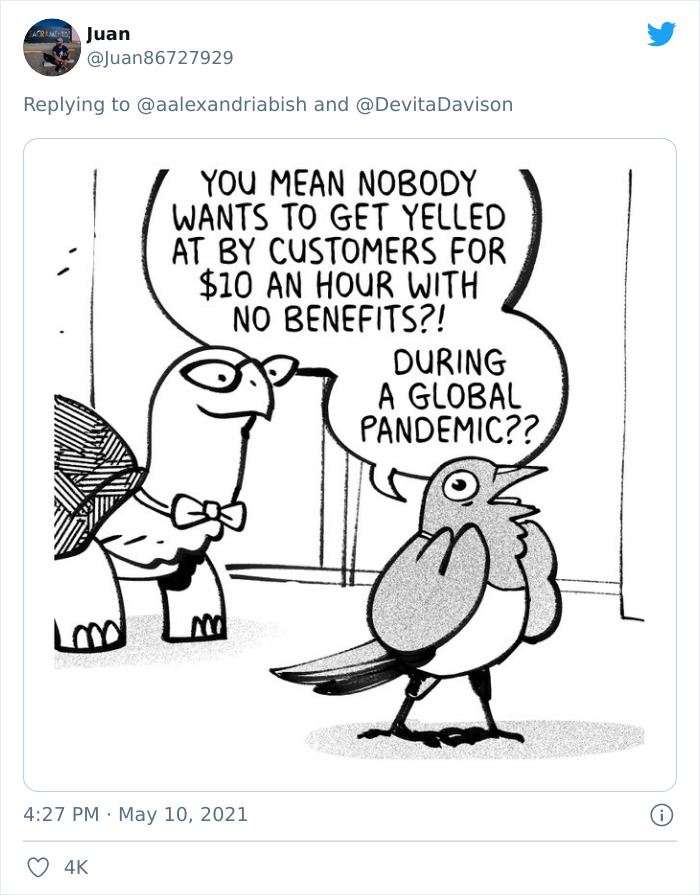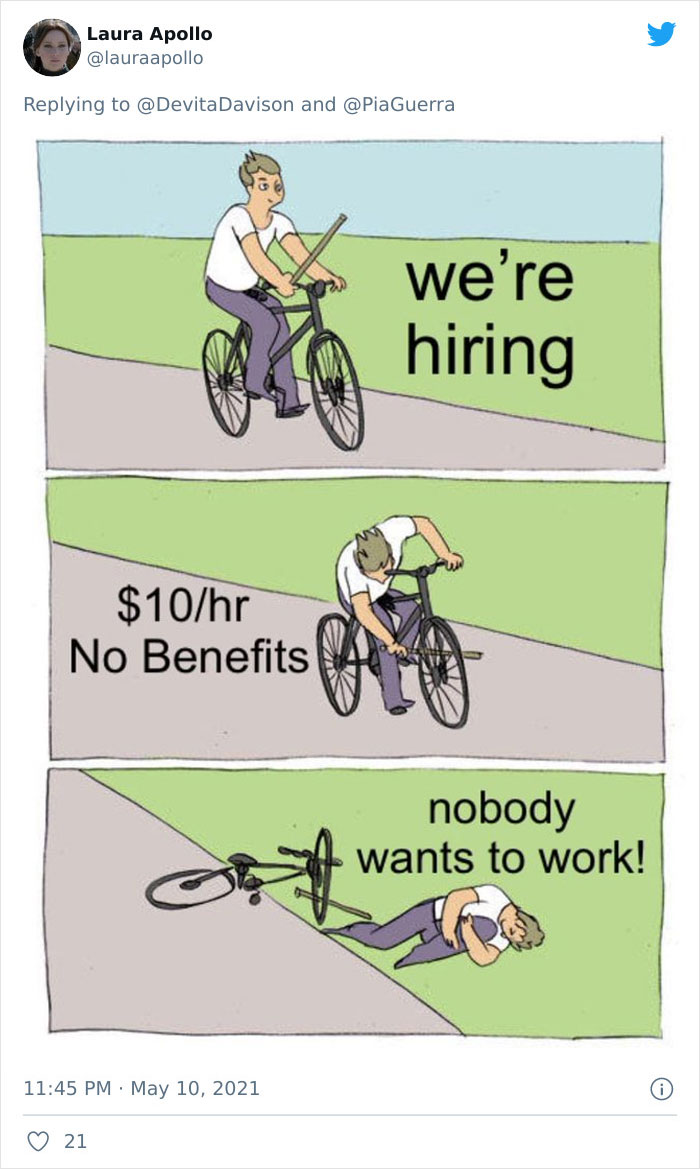
Workers Make Truthful Signs About Why Employers Are Facing Staff Shortages
The US Labor Department reports that job openings rose to a two-year high in February, while in March employers added nearly 1M new jobs. In this new reality of the post-pandemic world when more and more businesses are reopening their doors, job openings are accelerating faster than people can send job applications.
Unsurprisingly, many business owners are frustrated with this whole situation as they complain over how nobody wants to work these days. But things are not that easy. A growing body of workers are now stepping up to voice their eye-opening reasons on why making frappuccinos and defrosting pies would not be the smartest idea right now. And these are way more complex than just “wanting” or “not wanting” to work.
So in order to be heard, workers are now making their own posters to defend themselves from being continually blamed for staffing shortages across the country. Read on below to see what people had to say about it all.
Workers have had enough of their employees crying over how “nobody wants to work” in times of pandemic, so they’re putting up paper signs to explain why that is
Image credits: DevitaDavison
Image credits: MattPostSaysHi
The recent A.U.S. Census survey conducted in March found that about 4.2 million adults aren’t looking for jobs, not because they’re scarce, but because of worries about catching the coronavirus, states The Wall Street Journey.
Another reason is that while businesses are reopening, many adult employees with children have no one to leave their kids with. Caregiving responsibilities have particularly affected potential female employees as in late March, more than half of schools were still in remote learning or combination classes. Many women feel torn at this point, realizing that they can’t do both—be a good stay-at-home mom and an exemplary employee.
Image credits: fightfor15
Image credits: Your_Pal_Billy
Image credits: BrandsOwned
Unemployment benefits have been the last resource for many unemployed people to support the economy with weekly expansions of $600. University of Chicago researchers have found that “benefit expansions during the pandemic were a more effective policy than predicted by standard structural models.” Their figures showed that “overall spending was 2.0-2.6 percent higher and employment only 0.2-0.4 percent lower as a result of the benefit expansions.”
Armed with wit, people started making memes about the whole “they don’t want to work” situation
Image credits: hotandpisces
Image credits: JMoneyRed
But these expansions are already set to finish in early September and economists are watching to see what that means for business owners and low-wage workers. The low-wage workers are the most affected by the pandemic quirks in the economy and they are likely to recover much slower than higher-wage workers.
Image credits: Rongill20
Image credits: JeffFromRegina
Image credits: patinmadison
Image credits: Lukethomas101
Image credits: SquirtGG
Image credits: SuzySnoozie
Image credits: Juan86727929
Image credits: AmyGarlic
Image credits: MaybeDavey24
Image credits: 719Happy303
Image credits: BigTinyBird
Image credits: batess
Image credits: lauraapollo
Image credits: MarsinCharge
Image credits: Talk_To_The_Hat
246Kviews
Share on FacebookI really hope this creates change for America, their wages and benefits they pay people always seem so shocking to outsiders. I'm excited for the change that could happen!
I own a small business that's seasonal my workers make 20$ hour plus benefits! I give supplemental income if they choose to collect unemployment for the 4 mths were closed and I have competitive prices. Don't tell me corporations can't pay a living wage and benefits how about th e CEOs stop taking 80 million dollar bonuses for the upkeep of their private jets and yachts. People who think this is ok are so damn idiotic. Stop worshipping billionaires you weirdos.
Thank you very much for your professional perspective. It's good to read from small business owners that they've made changes that were successful.
Load More Replies...Viva la revolucion! It's high time workers got a living wage. These are exciting times!
Yes! The last time wealth distribution and poverty were this lopsided on a national level, I believe guillotines were part of the solution.
Load More Replies...I really hope this creates change for America, their wages and benefits they pay people always seem so shocking to outsiders. I'm excited for the change that could happen!
I own a small business that's seasonal my workers make 20$ hour plus benefits! I give supplemental income if they choose to collect unemployment for the 4 mths were closed and I have competitive prices. Don't tell me corporations can't pay a living wage and benefits how about th e CEOs stop taking 80 million dollar bonuses for the upkeep of their private jets and yachts. People who think this is ok are so damn idiotic. Stop worshipping billionaires you weirdos.
Thank you very much for your professional perspective. It's good to read from small business owners that they've made changes that were successful.
Load More Replies...Viva la revolucion! It's high time workers got a living wage. These are exciting times!
Yes! The last time wealth distribution and poverty were this lopsided on a national level, I believe guillotines were part of the solution.
Load More Replies...



























324
150